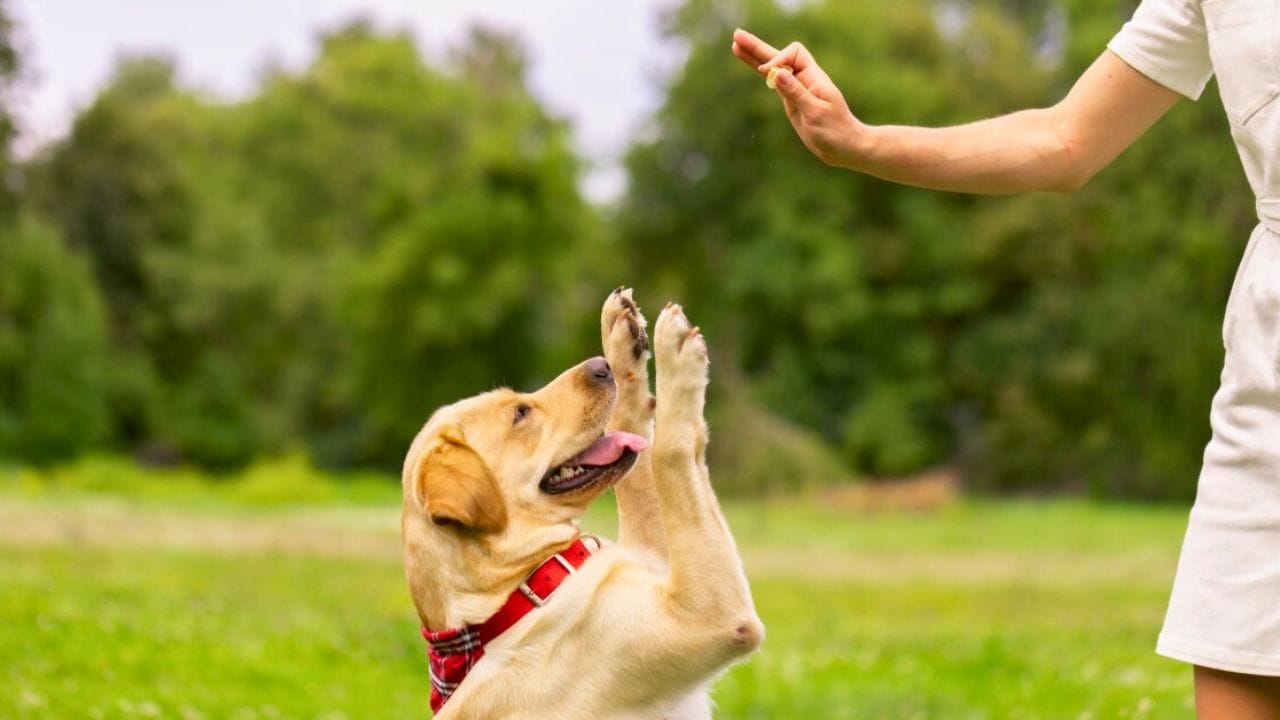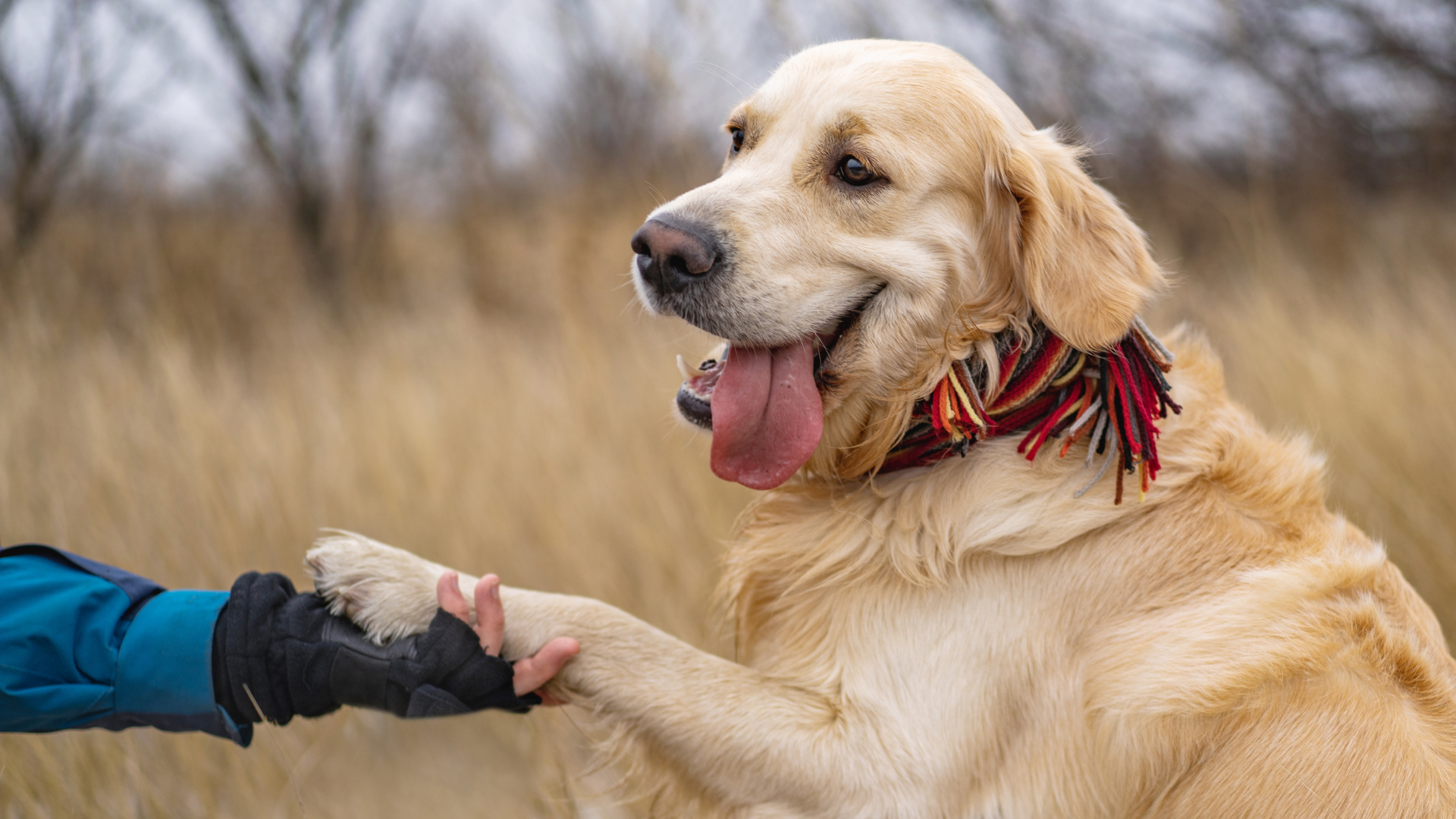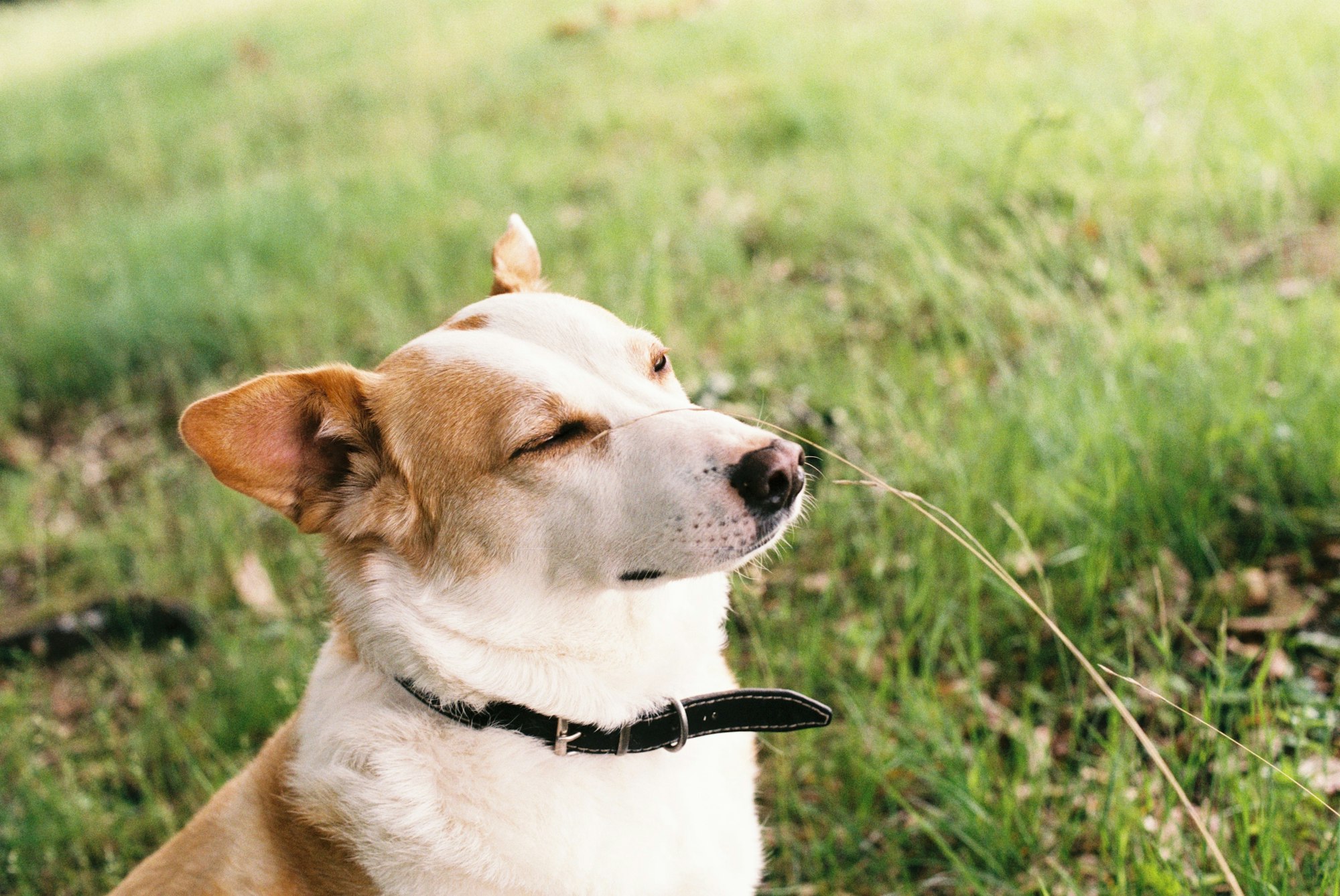Dog hand signals are an effective way to communicate with your furry friend. Dogs are intelligent and can learn to respond to visual cues as well as verbal commands. Hand signals can be particularly useful in situations where verbal communication is difficult, such as in noisy environments or when your dog is at a distance.

There are several basic hand signals that every dog owner should know. For example, a raised hand with the palm facing out can signal "stop" or "stay." Pointing with one finger can indicate "come" or "go," while a sweeping motion with the hand can mean "down" or "lie down." Other common signals include a raised hand with the index finger pointing up for "sit," and a closed fist with the thumb pointing up for "heel."
Dog hand signals can be taught through repetition and positive reinforcement. It's important to be consistent when using hand signals, and to always pair them with the corresponding verbal command. With practice, your dog will learn to respond to both visual and verbal cues, making training and communication easier and more effective.
Basics of Dog Hand Signals
Understanding Canine Body Language
Before attempting to use hand signals for training, it is important to understand canine body language. Dogs communicate through body language, and their behavior can tell a lot about their mood and intentions. For example, a wagging tail can indicate excitement or happiness, while a tucked tail can indicate fear or anxiety.
Other important body language cues include ear position, eye contact, and body posture. Understanding these signals can help trainers communicate more effectively with their dogs and avoid misunderstandings.

Essential Hand Signals
There are several essential hand signals that every dog owner should know. These include:
- Sit: Hold your hand up with your palm facing out and your fingers pointing up. Then, move your hand down towards the ground.
- Stay: Hold your hand up with your palm facing out and your fingers pointing up. Then, move your hand away from your body.
- Come: Hold your hand up with your palm facing out and your fingers pointing up. Then, move your hand towards your body.
- Heel: Hold your hand up with your palm facing out and your fingers pointing up. Then, move your hand towards your hip.
These signals are easy to learn and can be used to teach basic obedience commands.
Training Foundations
When training a dog to respond to hand signals, it is important to start with the basics. Trainers should use positive reinforcement techniques, such as treats and praise, to encourage desired behaviors.
It is also important to be consistent with hand signals. Trainers should use the same signal for each command every time, to avoid confusing the dog.
Finally, trainers should be patient and persistent. Learning new behaviors takes time, and it is important to give dogs plenty of opportunities to practice and succeed. With consistent training and positive reinforcement, dogs can quickly learn to respond to hand signals and become well-behaved companions.
Training Techniques
Positive Reinforcement
Dog training is a process that requires patience, consistency, and positive reinforcement. Positive reinforcement is the most effective way to train your dog, and it involves rewarding your dog for good behavior. Rewards can be in the form of treats, toys, or praise. When your dog exhibits good behavior, reward them immediately, so they understand what they did right.

Consistency and Repetition
Consistency and repetition are key factors in dog training. Dogs learn best when they are taught the same thing repeatedly in a consistent manner. Therefore, it is important to use the same hand signals and commands every time you train your dog. This will help your dog understand what you want them to do and make training easier.
Increasing Difficulty Gradually
Once your dog has learned the basic hand signals, you can start increasing the difficulty gradually. This means adding distractions or increasing the distance between you and your dog. For example, if your dog has learned the "sit" command, you can start asking them to sit when there are other dogs around or when you are at a distance. This will help your dog learn to obey commands even in challenging situations.
Using these training techniques, you can effectively teach your dog hand signals. Remember to be patient, consistent, and use positive reinforcement to achieve the best results.
Common Hand Signals
When it comes to dog training, hand signals can be just as important as verbal commands. Dogs are highly visual animals, so using hand signals can help them understand what you want them to do more quickly and easily. Here are some common hand signals for basic commands:
Sit Command
The sit command is one of the most basic commands you can teach your dog. To signal the sit command, raise your hand from your side to be parallel with the floor. You can also point your index finger up to reinforce the command. Make sure to praise and reward your dog when they sit.
Stay Command
The stay command is important for keeping your dog in one place. To signal the stay command, hold your hand open and palm out to the dog. You can also use a closed fist to reinforce the command. Make sure to praise and reward your dog when they stay.
Down Command
The down command is useful for getting your dog to lie down. To signal the down command, point to a specific spot for the dog to lie down. You can also use an open hand with palm down to reinforce the command. Make sure to praise and reward your dog when they lie down.

Come Command
The come command is important for getting your dog to come to you. To signal the come command, hold your hand out with your palm facing up and call your dog's name. You can also use a finger-pointing motion to reinforce the command. Make sure to praise and reward your dog when they come to you.
Heel Command
The heel command is useful for getting your dog to walk calmly beside you. To signal the heel command, hold your hand with your fingers pointing down and your palm facing your leg. You can also use a tapping motion on your leg to reinforce the command. Make sure to praise and reward your dog when they walk beside you calmly.
Overall, using hand signals can be a great way to communicate with your dog during training. By using consistent signals and rewarding good behavior, you can help your dog learn commands more quickly and effectively.
Advanced Hand Signals
Dog training is an ongoing process, and once your dog has mastered the basic commands, it's time to move on to advanced hand signals. These signals are used to communicate with your dog from a distance, off-leash, or to perform tricks.
Distance Control
Distance control is essential for dog owners who want to train their dogs to respond to commands from a distance. To train your dog for distance control, start with basic hand signals and gradually increase the distance between you and your dog. You can use a combination of verbal commands and hand signals to communicate with your dog.
Some examples of distance control hand signals include:
- A flat hand held out to the side for "stay"
- A hand pointing to the ground for "down"
- A hand held up high for "sit"
- A hand waving in a circular motion for "come"
Off-Leash Commands
Off-leash commands are essential for dog owners who want to train their dogs to respond to commands without the use of a leash. To train your dog for off-leash commands, start with basic hand signals and gradually increase the distance between you and your dog. You can use a combination of verbal commands and hand signals to communicate with your dog.

Some examples of off-leash hand signals include:
- A hand held out to the side for "stay"
- A hand pointing forward for "go"
- A closed fist for "come"
- A hand waving in a circular motion for "heel"
Performing Tricks
Performing tricks is a fun way to bond with your dog and show off their skills. To train your dog for tricks, start with basic hand signals and gradually increase the complexity of the signals. You can use a combination of verbal commands and hand signals to communicate with your dog.
Some examples of trick hand signals include:
- A hand held up high for "beg"
- A hand waving in a circular motion for "spin"
- A hand held out to the side for "play dead"
- A hand pointing to the ground for "crawl"
Overall, advanced hand signals are an excellent way to communicate with your dog and take your training to the next level. With patience and consistency, your dog can learn to respond to these signals and become a well-trained companion.
Troubleshooting and Challenges
Common Training Issues
Dog training is not always an easy process, and it's common to encounter a few issues along the way. When it comes to hand signals, some dogs may struggle to understand what you're asking them to do. In some cases, this could be due to a lack of consistency in the way you're using the hand signals. It's important to make sure you're using the same signal every time you ask your dog to perform a specific behavior.
Another common issue is that some dogs may not be able to see the hand signals clearly, especially if they have poor vision or are easily distracted. In these cases, it may be helpful to use a more exaggerated or pronounced hand signal to make it easier for the dog to see.
Adjusting to Different Dogs
Different dogs may respond differently to hand signals, so it's important to be patient and flexible in your approach. Some dogs may pick up on hand signals quickly and easily, while others may take more time to adjust. It's important to be consistent in your training and to adjust your approach as needed to help your dog understand what you're asking of them.
Overcoming Distractions
Distractions can be a major challenge when it comes to training dogs to respond to hand signals. It's important to start training in a quiet, distraction-free environment and gradually increase the level of distractions as your dog becomes more comfortable with the hand signals. You can also use treats or other rewards to help keep your dog focused on the task at hand.

Overall, with patience, consistency, and the right approach, it is possible to train your dog to respond to hand signals effectively. By troubleshooting common issues, adjusting to different dogs, and overcoming distractions, you can help your dog learn to understand and respond to your hand signals with ease.
Safety and Considerations
Public Spaces and Etiquette
When using hand signals in public spaces, it is important to be aware of other people and their pets. Dog owners should always ask for permission before approaching another person's dog, and should respect the other owner's decision if they decline. When training a dog in public, it is important to keep them on a leash and under control at all times. This will help prevent any accidents or misunderstandings with other dogs or people.
In addition, dog owners should be aware of their dog's behavior and body language. If a dog is showing signs of aggression or discomfort, it is important to remove them from the situation immediately. This can include growling, barking, or showing teeth. Owners should also be aware of their own body language and tone of voice, as this can affect their dog's behavior.
Dog's Individual Limits
Every dog has their own limits and abilities when it comes to training and learning hand signals. It is important for owners to be patient and understanding with their dog, and to not push them beyond their limits. Dogs may have physical or mental limitations that make certain hand signals difficult or impossible for them to learn.
Owners should also be aware of their dog's age and health. Older dogs or dogs with health issues may have more difficulty learning new hand signals, and may require more time and patience. It is important to consult with a veterinarian if there are any concerns about a dog's ability to learn and perform hand signals.
Legal Responsibilities
Dog owners have legal responsibilities when it comes to their pet's behavior in public spaces. This includes following local leash laws and cleaning up after their dog. If a dog causes damage or injury to another person or pet, the owner may be held responsible. It is important for owners to be aware of their legal responsibilities and to take steps to prevent any incidents from occurring.

Conclusion
Training your dog using hand signals can significantly enhance communication and obedience, making your bond stronger and more effective. By understanding canine body language, consistently using clear signals, and applying positive reinforcement techniques, you can teach your dog a variety of commands and even advanced tricks.
Remember to be patient and adjust your methods to suit your dog's individual needs and limitations. Always consider safety and etiquette in public spaces, respecting other people and pets. With dedication and consistency, your dog will become a well-trained companion, capable of responding to both verbal and visual cues, enriching your relationship and ensuring a harmonious living environment.

